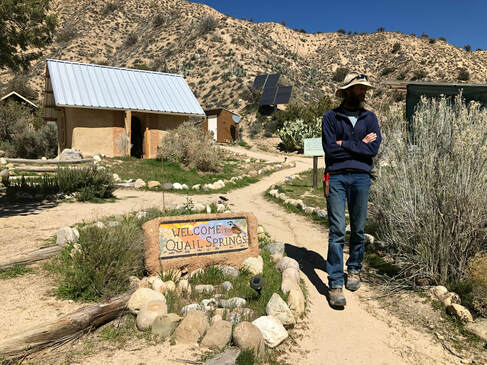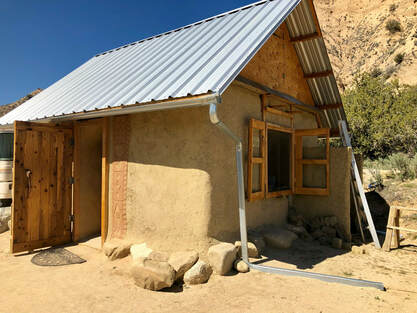Quail Springs Permaculture

When I worked as an environmental educator in rural Georgia for less than $10 an hour, freshly graduated from 22 straight years of education, something happened that forever changed me. We were hosting a group of 8th graders from Atlanta, many boasting gang symbols and flat expressions upon first arrival. As the day progressed, I witnessed layers of heartbreak, inadequacy and anger flow away downstream as we searched for macroinvertebrates. One young man ran towards me in pure joy, shouting “Ms. Brain, Ms. Brain, a bird!” This bird was a Tiger Swallowtail – yes, a butterfly – but my correction was swallowed in the light of his joy. The classroom had never fostered such hope for humanity as that day in a Georgia stream.
What happens when we touch, taste, are scratched by, and cry in awe over our natural environment? Our natural environment. Something can move us unexpectedly into the realm of the people care ethic of permaculture, closely interwoven with earth care. Large portions of our society have never immersed themselves in nature. This is a byproduct of our developed, plugged in, concrete, artificially lit, busy is better operating system. Many have not had any opportunity to develop a passion for the elements that allow our survival as humans on this beautiful planet. And we are longing to fill the void. We do not have to grapple through life under the overwhelming message that we aren’t enough. Nature immersion, whether on a small urban plot or protected wilderness area, allows us as educators to offer a meaningful alternative to the broken message of inadequacy where the best way to fill the void is through our credit cards.
Quail Springs Permaculture was created in 2004 by Warren Brush, internationally renowned permaculturalist, to address this gap in nature connectedness. Targeting young at-risk high school students, the site offered a deeper connection with nature, themselves, and their peers in a place where the water comes from the watershed and food from the farm. The site is a 450-acre former cattle ranch in the high desert rain shadow of coastal California. Back then, the property included a hanger, an air strip, arid heavily grazed land and a pond. Through years of passion to regenerate the land and contributions from educators, students, interns, and donors, that pond is now in the middle of a food forest and is filled with great western toads and common snipe.
Quail Springs offers what Brenton Kelly, Watershed Steward, calls “nature awareness programming.” This type of programming includes all aspects of tracking, recognizing the behavior of specific organisms in the environment, inner tracking or reflection, primitive/origin skills, integrated organic farming, healthy and humane butchering, and more. A dedication to reconnection. About 2,000 program participants engage with the site each year, immersing themselves in nature through programs generally ranging from five days to two weeks. Numerous surrounding schools visit representing all grade levels, along with people come from all over the world. Course offerings include traditional Permaculture Design Certifications (PDCs) (their last PDC had 34 enrolled) and an international development design course for agencies and organizations sending people to various countries to do aid development work; critically needed people care and earth care training. A youth program is offered each summer called Sustainable Vocations that includes a green jobs fair with information ranging from beekeeping to solar installation (which provides youth an understanding of what a green job is outside of the typical nonsensical imagery of a man standing in a green field wearing a business suit with a leaf in his pocket, holding a briefcase). For those wanting a full immersion, a farm internship program is offered and so is a natural building program with a variety of construction methods demonstrated and implemented. Regarding natural building, Quail Springs is also engaged in advocacy for this design approach. They serve as a research site for physics majors at California Polytechnic Institute, writing the codes for monolithic adobe walls and Influencing international and American building codes.
 What do people get when they come to Quail Springs? According to Brenton, they “get an experience this landscape offers that is not something we can even put on a brochure.” When they walk away, two areas of knowledge and skills change are hoped for: “one is that permaculture is never a perfection. I love to say that our systems are completely in chaos and need an infinite amount of energy that we now know we would want to redesign differently because we learned something in the last iteration of the process…you don’t come to Quail Springs or look at any permaculture site as going ‘oh, there’s the answer! There’s the solution! There’s the one size that fits all!’ I’m a big reactionary to the permaculture dogma syndrome where ‘berms and swales, berms and swales, save the world with berms and swales. Every design ought to have a spiral herb garden’ – all of the check the box kind of approach in permaculture …The other part is inspiring the optimism that it will require to maintain enough energy to solve these problems. If it is possible to live in this high desert and address some of those issues and come up with some real tangible solutions and live in a world that has ethical balance between those three permaculture ethics, principles are engaged and responsibility is held for our metabolic transactions, then there is a future. If we can do it out here with high desert minimal resources, then surely we can find a way to survive in the luxury of our larger metropolitan areas and in the lives that most people live in.”
What do people get when they come to Quail Springs? According to Brenton, they “get an experience this landscape offers that is not something we can even put on a brochure.” When they walk away, two areas of knowledge and skills change are hoped for: “one is that permaculture is never a perfection. I love to say that our systems are completely in chaos and need an infinite amount of energy that we now know we would want to redesign differently because we learned something in the last iteration of the process…you don’t come to Quail Springs or look at any permaculture site as going ‘oh, there’s the answer! There’s the solution! There’s the one size that fits all!’ I’m a big reactionary to the permaculture dogma syndrome where ‘berms and swales, berms and swales, save the world with berms and swales. Every design ought to have a spiral herb garden’ – all of the check the box kind of approach in permaculture …The other part is inspiring the optimism that it will require to maintain enough energy to solve these problems. If it is possible to live in this high desert and address some of those issues and come up with some real tangible solutions and live in a world that has ethical balance between those three permaculture ethics, principles are engaged and responsibility is held for our metabolic transactions, then there is a future. If we can do it out here with high desert minimal resources, then surely we can find a way to survive in the luxury of our larger metropolitan areas and in the lives that most people live in.”
At Quail Springs, participants give through contributing to the site financially and manually. “Most of the buildings that we live in are built through workshops where people came, ate our food, crapped in our toilets, made their footprints and fingerprints on the walls of our homes and went home with enough of a knowledge base that they could actually put mud on a wall and build something, or plant a tree, whatever their next step in integrated living is.”
When reflecting further on the meaning – and misperceptions of – permaculture, Brenton stated “permaculture, that’s organic gardening right? Or permaculture, that’s natural building. They are facets on a gem that’s too dazzling to really observe in its integrated true self. So how we do that is through experience.” And according to Brenton, it is the experiential aspect which has helped create a stronger connection with nature and more hands-on skills then the stand-alone academic nature of the PDC. At Quail Springs, participants might milk goats, butcher a chicken, turn a compost pile, harvest produce, and more. “I mean at some point you are going to have people all academic’d up and no place to go.” As a result, “we do a lot more hands-on workshops where permaculture isn’t really what they are signing up for. They are signing up for a natural building course or an edible wild landscape culinary course, or a garden farm community course. It’s all permaculture.” And these facets of the permaculture gem are helping to re-immerse and reground us in the natural environment that allows for our survival. Programs offering this reconnection with nature through human bonding and hands-on experience allow a reshaping of our relationshis. We hold limitless depth in potential to regenerate our social and environmental systems, and moving away from a parasitic relationship with others and our planet brings me back to that light of hope I felt over a decade ago in a Georgia stream.
To discover more about Brenton and Quail Springs Permaculture, visit: http://www.quailsprings.org

Recent Posts

